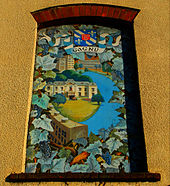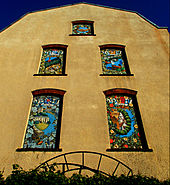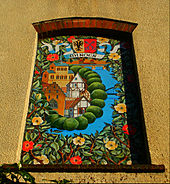Sister city

A sister city or a twin town relationship is a form of legal or social agreement between two geographically and politically distinct localities for the purpose of promoting cultural and commercial ties.[1]
While there are early examples of international links between municipalities akin to what are known as sister cities or twin towns today dating back to the 9th century,[2] the modern concept was first established and adopted worldwide during World War II.[3][4]
Origins of the modern concept[edit]
Throughout history, many cities have participated in various cultural exchanges and similar activities that might resemble a sister-city or twin-city relationship, but the first officially documented case of such a relationship was a signed agreement between the leaders of the cities of Toledo, Ohio and Toledo, Spain in 1931.[5] However, the modern concept of town twinning really grew during the Second World War. More specifically, it was inspired by the bombing of Coventry on 14 November 1940, known as the Coventry Blitz.[3] First conceived by the then Mayor of Coventry, Alfred Robert Grindlay,[6] culminating in his renowned telegram to the people of Stalingrad (now Volgograd) in 1942,[7][8][9] the idea emerged as a way of establishing solidarity links between cities in allied countries that went through similar devastating events.[10]
The comradeship between the two cities continued, when again in response to the Battle of Stalingrad, 830 women in Coventry – led by the subsequent Mayor Emily Smith – had their names embroidered on a tablecloth along with the words "Little help is better than a lot of pity" and sent it, along with money (each donated six pence), to the people of Stalingrad.[11][4][12] The tablecloth can now be seen at the Panorama Museum of the Battle of Stalingrad.
The twinning between Coventry and Stalingrad was formalized in 1944 [13] and, after the end of the war, similar links were established to foster friendship and understanding among former foes as an act of peace and reconciliation,[2][14] with new twinnings between Coventry and German cities: Kiel as early as in 1947 and Dresden in 1956.[3] In 1957, Coventry was officially twinned with Belgrade, even though the link actually dates back to 1953 when then Yugoslav Ambassador visited Coventry and offered a gift of timber from his native country for use in the new Civic Theatre, which when finished was named Belgrade Theatre.[15]
The purpose of twinnings was then expanded to encourage trade and tourism[1] or to reflect other links, such as towns sharing the same name or migration links.[16] By the 2000s, town twinning became increasingly used to form strategic international business links among member cities,[17][18] and may include localities of any scope such as villages, prefectures, or countries.
Terminology[edit]

In the United Kingdom, the term "twin towns" is most commonly used; the term "sister cities" is generally used for agreements with towns and cities in the Americas.[1][19] In mainland Europe, the most commonly used terms are "twin towns", "partnership towns", "partner towns", and "friendship towns". The European Commission uses the term "twinned towns" and refers to the process as "town twinning".[1][19] Spain uses the term "ciudades hermanadas", which means "sister cities". Germany, Poland, and the Czech Republic each use Partnerstadt (German), miasto partnerskie (Polish) and partnerské město (Czech), which translate as "partner town" or "partner city". France uses ville jumelée (jumelage, twinned town or city), and Italy has gemellaggio (twinning) and comune gemellato (twinned municipality).[20] In the Netherlands, the term is partnerstad or stedenband ("city bond" when providing mutual support). In Greece, the word αδελφοποίηση (adelphopiisi – fraternisation) has been adopted. In Iceland, the terms vinabæir (friend towns) and vinaborgir (friend cities) are used. In the former Soviet Bloc, "twin towns" and "twin cities" were used,[21] and in Russian, they use города-побратимы (sworn brother cities).[22][23]
The Americas, South Asia, and Australasia use the term "sister cities" or "twin cities". In China, the term is 友好城市 (yǒuhǎo chéngshì – friendly cities).[24] Sometimes, other government bodies enter into a twinning relationship, such as the agreement between the provinces of Hainan in China and Jeju in South Korea. The Douzelage is a town twinning association with one town from each of the member states of the European Union.[1][25]
Though the term is often used interchangeably with the term "friendship city", this may mean a relationship with a more limited scope in comparison to a sister city relationship, and friendship city relationships are mayor-to-mayor agreements.[26]
City diplomacy[edit]

City diplomacy is a form of paradiplomacy that involves discussions between officials and residents of different cities. Often these cities will be located in different countries. As such, city diplomacy involves a sort of international relations that works in parallel to the conventional system involving embassies, ambassadors, and treaties negotiated at the level of nation states. According to Rodrigo Tavares, the earliest formal attempts to establish city diplomacy across national boundaries took place in the 19th century. Only a handful of cities were involved in the 19th-century efforts; it was not until the turn of the millennium that it became much more common.[27] The first priority of those carrying out city diplomacy typically overlaps with the core aims of municipal government – improving the lives of local residents. Yet they will often collaborate with peers in other cities to work on issues of planet-wide concern, such as efforts to address climate change.[28][27]
The phrase "city diplomacy" is formally used in the workings of the United Cities and Local Governments and the C40 Cities Climate Leadership Group, and is recognised by the USC Center on Public Diplomacy. A March 2014 debate in the British House of Lords acknowledged the evolution of town twinning into city diplomacy, particularly in matters of trade and tourism, but also in culture and post-conflict reconciliation.[29] The importance of cities developing "their own foreign economic policies on trade, foreign investment, tourism and attracting foreign talent" has also been highlighted by the World Economic Forum.[30] In addition to C40, other organisations facilitating city diplomacy include the World Cities Summit, City Mayors Foundation, the Smart City Expo World Congress,[31] the Strong City Network[32] and 100 Resilient Cities.[33][28] As of 2016, there were over 125 such multilateral networks and forums to facilitate international collaboration between different municipal authorities.[27] A Bill introduced in the 2019 session of the US Congress would have legislated for a City and State Diplomacy Act to create a new Office of Subnational Diplomacy at the Department of State.H.R.3571 - 116th Congress (2019-2020): City and State Diplomacy Act.
Recently, the field of city diplomacy has taken a step beyond city-to-city exchanges to target the facilitation of dialogue between cities and multilateral organs, such as the United Nations.[34]
Twinning beyond cities and towns[edit]
Not only cities and towns, but also provinces, states, territories, and regions enter into twinning agreements. For example, the Canadian province of Alberta has "sister province" agreements with Gangwon, South Korea (since 1974), Hokkaido, Japan (since 1980), Heilongjiang, China (1981), Jalisco, Mexico (1999), Ivano-Frankivsk, Ukraine (2004), Lviv, Ukraine (2005), and Guangdong, China (2017), and California, United States (2018), as well as policy-oriented (as opposed to economic and cultural) agreements with Nevada, United States (since 2013), Missouri, United States (2015), Texas, United States (2018).[35][36]
Europe[edit]
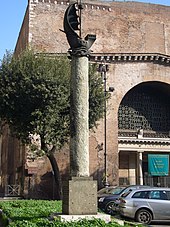
The earliest known town twinning in Europe was between Paderborn, Germany, and Le Mans, France, in 836.[2][37] Starting in 1905, Keighley in West Yorkshire, England, had a twinning arrangement with French communities Suresnes and Puteaux.[38][39] The first recorded modern twinning agreement was between Keighley and Poix-du-Nord in Nord, France, in 1920 following the end of the World War I.[18][39][40][41] This was initially referred to as an adoption of the French town; formal twinning charters were not exchanged until 1986.[42]
The practice was continued after the Second World War as a way to promote mutual understanding and cross-border projects of mutual benefit.[1][2][43][44][45] For example, Coventry twinned with Stalingrad and later with Dresden as an act of peace and reconciliation, all three cities having been heavily bombed during the war.[1][41][46][47][48] The city of Bath formed an "Alkmaar Adoption committee" in March 1945, when the Dutch city was still occupied by the German Army in the final months of the war, and children from each city took part in exchanges in 1945 and 1946.[49] Similarly, in 1947, Bristol Corporation (later Bristol City Council) sent five "leading citizens" on a goodwill mission to Hanover.[18][41] Reading in 1947 was the first British town to form links with a former "enemy" city – Düsseldorf, a link that still exists.[50] Since 9 April 1956 Rome and Paris have been exclusively and reciprocally twinned with each other, following the motto: "Only Paris is worthy of Rome; only Rome is worthy of Paris."[51][52]
Within Europe, town twinning is supported by the European Union.[1][2][18] The support scheme was established in 1989. In 2003 an annual budget of about €12 million was allocated to about 1,300 projects. The Council of European Municipalities and Regions also works closely with the commission (DG Education and Culture) to promote modern, high quality twinning initiatives and exchanges that involve all sections of the community. It has launched a website dedicated to town twinning.[53] As of 1995, the European Union had more than 7,000 bilateral relationships involving almost 10,000 European municipalities, primarily French (2837 twinnings) and German (2485 twinnings).[45]
Public art has been used to celebrate twin town links, for instance in the form of seven mural paintings in the centre of the town of Sutton, Greater London. The five main paintings show a number of the main features of the London Borough of Sutton and its four twin towns, along with the heraldic shield of each above the other images. Each painting also features a plant as a visual representation of its town's environmental awareness.[54] In the case of Sutton this is in a separate smaller painting (above its main one) showing a beech tree, intended as a symbol of prosperity and from which Carshalton Beeches in the borough derives its name.[55]
Another example of the use of public art is the wall sculpture of the partner cities of Munich, Germany.
A recent study has concluded that geographical distance has very little, if any, influence upon communities' selections of a twin town.[56] Twinned towns are often chosen because of similarities between them; thus about 15 towns in Wales are twinned with towns in Brittany, and Oxford is with Bonn, Leiden, Grenoble and other university cities.[1] In Italy, two sets of twins are Rovigo with Viernheim, and Bedford with Tulcea. Many former West German cities are twinned with former East German cities; these twinning links were established before the fall of the Iron Curtain. Famous examples are the partnerships of Hanover and Leipzig, both of which have important trade fair grounds, or between Hamburg and Dresden. The first US-German town twinning was in 1947 between Worthington, Minnesota and Crailsheim.[1] St Petersburg in Russia holds the record for the largest number of partnership arrangements with other communities.[56] In June 2012, the Scottish village of Dull and the US town of Boring, Oregon, agreed to twin their municipalities to promote tourism in both places, playing on their names.[57][58][59]
Recently some towns have made novelty twinning arrangements with fictional or virtual locations. Wincanton, England is partnered with Ankh-Morpork from Terry Pratchett's Discworld books.[60]
Town twinning has increasingly been used to form strategic international business links. For example, in the 1990s, when the Nottingham City Council in the UK considered installing a tram network, it consulted experts from its twin city of Karlsruhe, which has one of the most extensive and efficient tram networks in Germany. With assistance from Karlsruhe's specialist engineers, Nottingham completed its second tram line in 2013.[17] In 2014, Bristol and New Orleans announced their intention to form a "tuning" partnership based on a shared musical heritage and culture offer, at the initiative of Bristol Mayor George Ferguson.[61] Annecy, France and Nerima, Tokyo have for several years shared a partnership based on their "co-existent animation industry".[62][63]
North America[edit]
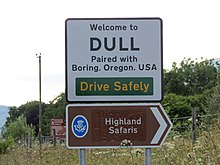
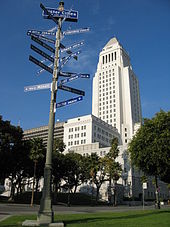
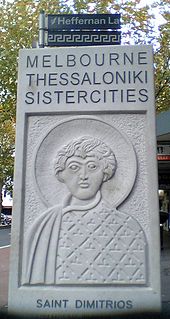
Toledo, United States, twinned with Toledo, Spain, in 1931 and was the first city in North America to engage in town twinning.[5] Vancouver, Canada, twinned[65] with Odesa, Ukraine, in 1944 was the first in Canada and second in North America while Denver, United States, twinned with Brest, France was the second twinned city in the United States. Liberal, Kansas, was twinned with Olney, United Kingdom, in 1950, and the cities have run a joint Pancake Day race ever since.[66][67] Littleton, Colorado, twinned with Bega, Australia, in 1961. Tashkent, the capital city of Uzbekistan, was twinned with Seattle, Washington, in 1973. Rochester, Minnesota, and Knebworth, UK, are both centers for primary medical research, and they twinned in 1967. Ontario, California, has five sister cities around the world. They are Brockville, Ontario, Canada (since 1977), Guamúchil, Sinaloa, Mexico (since 1982), Mocorito, Sinaloa, Mexico (since 1982), Los Mochis, Sinaloa, Mexico (since 1988), and Winterthur, Canton of Zürich, Switzerland. Oakville, Ontario, is twinned with Dorval, Quebec, Huai'an, China, and Neyagawa, Osaka, Japan.[68]
Town twinning begins for a variety of reasons. Generally, partner towns have similar demographics and size. They may arise from business connections, travel, similar industries, diaspora communities, or shared history. For example, the partnership between Portland, Oregon, and Bologna, Italy, arose from shared industries in biotechnology and education, and a "similar attitude towards food",[69] whereas Chicago's link with Warsaw, Poland began with Chicago's historic Polish community.[70] The twinning of Indianapolis with Monza, Italy, is due to both cities' long association with auto racing.
A twin towns program was instituted in the United States in 1956 when President Dwight D. Eisenhower proposed a citizen diplomacy initiative. Sister Cities International (SCI) was originally a program of the National League of Cities, but it became a separate corporation in 1967 due to the growth and popularity of the program.[71]
Twin town cultural events include the annual National Cherry Blossom Festival in Washington, D.C., honoring Washington's twin relationship with Tokyo City. Many twinned towns developed business agreements with their partners. For example, Vermont's Ben & Jerry's Ice Cream company opened a factory in the Republic of Karelia in Russia and offered the same profit-sharing plan to its Russian employees.
South America[edit]
Asia[edit]
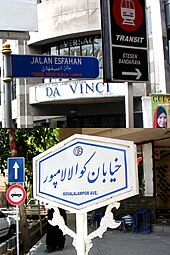
China's sister city relationships are managed by the Chinese People's Association for Friendship with Foreign Countries, a united front organization.[72] Town twinning is supported in Japan by the Council of Local Authorities for International Relations, a joint agency of local governments established by the Japanese government in 1988 (similar to Sister Cities International, its counterpart in the US). In Japan, the international city relations may be split into multiple terms, such as Sister Cities, Friendship Cooperation Cities, Business Partner Cities (BPC), Memorandum of Understanding (MOU), Sister Ports / Friendship Ports, etc.[73] China mostly uses the term "friendship cooperation cities" rather than "sister cities", as the Chinese words for sisters, "姐妹" (reading: jiěmèi, literally elder sister and younger sister), could imply a hierarchical relationship. More recently, Tokyo has begun to actively promote 'city diplomacy' with other global cities at the initiative of its governor Yoichi Masuzoe.[74]
Africa[edit]
Oceania[edit]
Linguistic reasons[edit]
Relationships between communities can also arise because of shared names; they may be named after one community (as in the case of Córdoba), they may share names (as in the case of Santiago de Compostela), or their names may have a common etymology. These similarities usually arise from sharing the same or related language or having been a colony or previously conquered.
Political significance[edit]
The twinning of towns and cities is sometimes done for political purposes. The Hungarian city Gyöngyös was twinned with the Azerbaijani city of Shusha in 2013, signing the twinning agreement with representatives from the Azerbaijani government; Hungary recognised Shusha as de jure part of Azerbaijan, even though it was controlled at the time and until 2020 by the military forces of Armenia and the unrecognised Republic of Artsakh.[75] An attempt was made in 2003 by Preston city councillors in England to twin with the Palestinian town of Nablus in the name of solidarity.[76]
Turkey bans partnerships with any city in a country that recognizes the Armenian genocide. As a result, when Bulgaria recognized the genocide in 2016, some twin agreements such as Edirne–Haskovo were terminated by Turkey.[77]
China manages sister city relationships through the Chinese People's Association for Friendship with Foreign Countries (CPAFCC). In April 2019, CPAFCC president Li Xiaolin said, “Friendship city relations have become one of the important channels to implement the Belt and Road Initiative.”[78] In January 2020, Shanghai canceled its sister city relationship with Prague after Prague's mayor signed a sister city relationship with Taipei.
In November 2020, U.S. senator Marsha Blackburn introduced legislation, the Sister City Transparency Act, to provide federal oversight to mitigate risks of sister city agreements being used for political influence campaigns.[79] In 2024, Indiana banned localities from entering into sister city agreements with six "foreign adversary" countries.[80]
Termination[edit]
- In 2012, the city of Nanjing suspended their sister city relationship with Nagoya after Nanjing Massacre denialist statements by Nagoya's mayor, Takashi Kawamura.[81]
- In 2013, the Italian cities of Milan, Venice, and Turin, formerly twinned with Saint Petersburg, suspended their links due to Russia's passage of anti-gay legislation.[82][83] Activists in California circulated petitions urging California cities and counties with relationships with Russian counterparts to take similar steps.[84]
- In 2014, Prague terminated its partnership with Saint Petersburg and Moscow because of the Russian military intervention in Ukraine. Moscow had been Prague's partner city since 1995.[85]
- In 2017, the mayor of Osaka, Hirofumi Yoshimura, ended the city's 60-year relationship with San Francisco due to the erection of a memorial to comfort women in downtown San Francisco.[86][87] Similarly, the cities of Glendale, California, and Higashiōsaka, Japan, came close to terminating their twinning in 2013 and 2014 because of an ongoing dispute over Glendale's support for the erection of a statue dedicated to Korean comfort women in a city park.[88]
- In July 2020, the town council of Nieuwegein, a Dutch city south of Utrecht, voted to end its friendship with Puławy in eastern Poland, citing "gay free zones" as the reason.[89]
- In March 2022, the City of Melbourne council voted unanimously to suspend its relationship with St Petersburg as a result of the on-going Russian invasion of Ukraine.[90]
- In March 2022, Doncaster cut ties[91] with their twin-town Ozyorsk due to the Russian invasion of Ukraine.[90]
- On 22 March 2022, Coventry voted to temporarily pause the city's link with Volgograd (formerly Stalingrad) and explore twinning with Mariupol instead due to the Russian invasion of Ukraine.[92]
- In February 2023, the mayor of Barcelona broke ties with twin city Tel Aviv citing Israeli apartheid as the reason.[93]
Gallery[edit]
-
Louisville's twin towns
-
Insignia of twin towns on town hall in Kralupy nad Vltavou, Czech Republic
-
Plovdiv, Bulgaria, twin towns directions
-
Twin town signs of Kemi, Finland
-
Twin town monument in Tawau, Sabah, Malaysia
-
Holon, Israel, a twin towns garden
-
Kragujevac and Suresnes twinning agreement
-
Zalaegerszeg, Hungary twinnings
See also[edit]
- Council of Local Authorities for International Relations
- Cross-border town naming
- Douzelage
- Global city
- Lists of twin towns and sister cities
- List of twin towns and sister cities in Europe
- Paradiplomacy
- Partnership2Gether
- Sister Cities International
- Twin cities
References[edit]
- ^ a b c d e f g h i j Clarke, N. "Town Twinning in Britain since 1945: A Summary of findings" (PDF). School of Geography, University of Southampton. Archived from the original (PDF) on 29 July 2013. Retrieved 29 July 2013.
- ^ a b c d e "The Origins of Town Twinning" (PDF). Inverness: The City of Inverness Town Twinning Committee. 8 December 2008. Archived from the original (PDF) on 31 December 2010. Retrieved 30 October 2009.
- ^ a b c "A tale of twin cities: how Coventry and Stalingrad invented the concept". The Guardian. 4 March 2016. Retrieved 20 May 2021.
- ^ a b Danks, Catherine. "I love Volgograd: the enduring wartime relationship with one British city". The Conversation. Retrieved 20 May 2021.
- ^ a b "Oldest Sister City Relationship Established Between Toledo, Ohio and Toledo, Spain – Sister Cities International (SCI)". Retrieved 11 December 2023.
- ^ "www.historiccoventry.co.uk". Archived from the original on 8 April 2011.
Roll of the Mayors of Coventry - 1941 Alfred Robert Grindley (Grindlay)
- ^ "www.talkingbirds.co.uk". Archived from the original on 26 December 2004.
Message from Coventry to Stalingrad (1941)
- ^ "Telegram from A.R. Grindlay, the mayor of Coventry, to the chairman of the Stalingrad city council of workers' deputies". Federal State Budgetary Institution of Culture 'The Battle of Stalingrad' State Historical and Memorial Museum and Heritage Site. 1942.
- ^ Kulishenko, Natalia (2020). An English Queen and Stalingrad: The Story Of Elizabeth Angela Marguerite Bowes-Lyon. Glagoslav Publications. ISBN 9781912894628.
Alfred Robert Grindlay's telegram to Stalingrad, 16 September 1942
- ^ "Coventry Telegraph: What is the point of Coventry's twin towns?". www.coventrytelegraph.net. 2 August 2011. Archived from the original on 18 June 2018.
Coventry was the first city in the world to twin with another. In 1944 Coventry started a trend that would spread across Europe and the rest of the world.
- ^ "Скатерть из Ковентри - Мей Адамс. Подробное описание экспоната, аудиогид, интересные факты. Официальный сайт Artefact". ar.culture.ru (in Russian). Retrieved 10 March 2024.
- ^ "World War II commemorations: the story of the Coventry tablecloth and Stalingrad". GOV.UK. Retrieved 20 May 2021.
- ^ Hook, Alison. "Volgograd, Russia". www.coventry.gov.uk. Retrieved 20 May 2021.
- ^ "What is town twinning?". L'Association des Communes Jumelées du Limousin. Archived from the original on 5 September 2013. Retrieved 5 September 2013.
- ^ "Belgrade, Serbia". Coventry City Council. Retrieved 14 February 2022.
- ^ "Who are we twinned with?". warwick.ac.uk. Retrieved 20 May 2021.
- ^ a b Brown, Tom (31 July 2013). "Twin towns: Do we still need them?". BBC East Midlands Today. BBC News. Retrieved 7 August 2013.
- ^ a b c d Handley, Susan. Barton, Judith (ed.). Take your partners – The local authority handbook on international partnerships (10 ed.). Local Government International Bureau. Archived from the original on 17 July 2011. Retrieved 13 August 2013.
{{cite book}}:|work=ignored (help) - ^ a b "Action 1 – Measure 1: Town Twinning". The Education, Audiovisual and Culture Executive Agency. Retrieved 26 August 2013.
- ^ "termine". thes.bncf.firenze.sbn.it. Retrieved 10 October 2019.
- ^ "Mogilev: Twin Towns – Twin Cities". Mogilev city executive committee. Retrieved 19 October 2013.
- ^ "Tbilisi, Vilnius become brother cities". Trend News Agency. Retrieved 12 October 2009.
- ^ Self-Pierson, Rob (30 April 2012). "Is there a point to twin towns?". The Guardian. Retrieved 14 July 2013.
- ^ "Sister City" (PDF). Archived (PDF) from the original on 16 May 2017. Retrieved 15 May 2017.
- ^ "Member towns". Douzelage. 21 September 2016. Retrieved 22 August 2021.
- ^ "What is the difference between a Sister City and a Friendship City? | AustinTexas.gov - The Official Website of the City of Austin". austintexas.gov. Retrieved 18 January 2018.
- ^ a b c Tavares, Rodrigo (2016). Paradiplomacy: Cities and States as Global Players. Oxford University Press. pp. 10–15, passim.
- ^ a b Hachigian, Nina (16 April 2019). "Cities Will Determine the Future of Diplomacy". Foreign Policy. Retrieved 11 November 2019.
- ^ "Lords Hansard text for 26 Mar 2014 (pt 0001)". Retrieved 26 April 2016.
- ^ "Five key lessons for city competitiveness". World Economic Forum. Archived from the original on 19 October 2014. Retrieved 26 April 2016.
- ^ "Smart City Expo World Congress". www.smartcityexpo.com. Retrieved 17 December 2019.
- ^ "Home". Strong Cities Network. Retrieved 17 December 2019.
- ^ "Home Page". 100 Resilient Cities. Retrieved 17 December 2019.
- ^ "Genève ambitionne de devenir le hub des réseaux de villes". Tribune de Genève (in French). ISSN 1010-2248. Retrieved 2 May 2022.
- ^ "International partnerships". www.alberta.ca.
- ^ "California-Alberta Relations" (PDF). Archived from the original (PDF) on 29 September 2018. Retrieved 29 September 2018.
- ^ Lelièvre, Jean; Balavoine, Maurice (1994). Le Mans-Paderborn, 836–1994: dans l'Europe, une amitié séculaire, un sillage de lumière (in French). Le Mans: M. Balavoine. pp. 1–42. Retrieved 9 August 2013.
- ^ Crane, Frank (2008). War and World Government. BiblioBazaar, LLC. p. 200. ISBN 978-0-559-44381-7. Retrieved 20 September 2009.
- ^ a b "France Magazine – Twin Towns". www.francemag.com. Retrieved 6 November 2009.
- ^ Handley, Susan (2006). Take your partners: The local authority handbook on international partnerships. London: Local Government International Bureau. p. 4. Archived from the original on 17 July 2011. Retrieved 20 September 2009.
- ^ a b c "Town twinning in the UK and Germany". East Street Arts. 6 October 2010. Retrieved 29 July 2013.
- ^ "Keighley celebrates twin town jubilee". Telegraph & Argus. Newsquest Media Group. 2002. Retrieved 5 January 2009.
- ^ "Ghajnsielem.com – Twinning". www.ghajnsielem.com. Archived from the original on 24 January 2013. Retrieved 10 October 2009.
- ^ "Twin Towns". www.amazingdusseldorf.com. Retrieved 29 October 2009.
- ^ a b Furmankiewicz, Marek (21 March 2004). "Town-twinning as a factor generating international flows of goods and people" (PDF). Institute of Geography and Regional Development, University of Wrocław, Poland. Archived from the original (PDF) on 29 July 2013. Retrieved 29 July 2013.
- ^ Griffin, Mary (2 August 2011). "Coventry's twin towns". Coventry Telegraph. Archived from the original on 6 August 2013. Retrieved 6 August 2013.
- ^ "Coventry—Twin towns and cities". Coventry City Council. Archived from the original on 12 April 2013. Retrieved 6 August 2013.
- ^ "Disney seeks UK twin" (Press release). www.ukprwire.com. Archived from the original on 3 July 2011. Retrieved 30 October 2009.
- ^ "Bath Alkmaar Twinning Association | ORIGINS". www.bath-alkmaar.eu. Retrieved 23 June 2017.
- ^ "Reading-Düsseldorf Association – Devoted to promoting & developing friendship between Reading and Düsseldorf". Retrieved 10 October 2019.
- ^ "Twinning with Rome". Archived from the original on 5 September 2012. Retrieved 27 May 2010.
- ^ "Les pactes d'amitié et de coopération". Mairie de Paris. Archived from the original on 11 October 2007. Retrieved 14 October 2007.
- ^ "Twinnings". Twinning.org. Retrieved 16 June 2009.
- ^ "Murals for Sutton twin towns to get new lease of life". Sutton Guardian. 12 June 2011. Retrieved 10 September 2014. "Murals for Sutton twin towns to get new lease of life". London News. 12 June 2011. Archived from the original on 11 September 2014. Retrieved 10 September 2014.
- ^ "Revealing Sutton's twinning heritage 06.06.11: A set of murals celebrating Sutton's links with its continental twin towns is to be given a new lease of life" (Press release). London Borough of Sutton press office. 6 June 2011. Archived from the original on 25 August 2014. Retrieved 10 September 2014.
- ^ a b Kaltenbrunner, Andreas; Aragon, Pablo; Laniado, David; Volkovich, Yana (16 February 2013). "Not all paths lead to Rome: Analysing the network of sister cities". arXiv:1301.6900 [cs.SI].
- ^ LeVeille, David. "A Tale of Dull and Boring Sister Cities". The World.org. Retrieved 15 July 2013.
- ^ "Boring in Oregon votes to pair with Dull in Perthshire". BBC News. 6 June 2012. Retrieved 26 April 2016.
- ^ Gambino, Lauren. "Dull and Boring? Sounds exciting". KVAL. Archived from the original on 22 October 2013. Retrieved 22 February 2013.
- ^ "Pratchett city twins with real town". British Broadcasting Corporation. 6 December 2002. Retrieved 5 September 2013.
- ^ "How Bristol could become the New Orleans of the UK". Bristol Post. 27 February 2014. Archived from the original on 19 August 2014. Retrieved 17 August 2014.
- ^ "'Stimulation Project for the Coexistent Animation Industry Cluster in Nerima', Nerima City, January 2009" (PDF). Retrieved 10 October 2019.
- ^ "'Using pop culture to assert distinctiveness of place', Japan Local Government Centre, London, March 2011" (PDF). Retrieved 10 October 2019.
- ^ "Greek twinnings" (PDF). Central Union of Municipalities & Communities of Greece. Retrieved 25 August 2013.
- ^ "1944". www.vancouverhistory.ca. Retrieved 21 May 2020.
- ^ "Liberal wins 60th Int'l Pancake race". United Press International (UPI). Retrieved 30 April 2011.
- ^ "Pancake Race 2007". Archived from the original on 6 February 2010. Retrieved 26 April 2016.
- ^ "Sister City". Town of Oakville Website. Retrieved 14 April 2020.
- ^ "Mission". Portland Bologna Sister City Association. Retrieved 16 July 2012.
- ^ Leroux, Charles (31 July 2001). "Chicago has assembled a sorority of sister cities". Chicago Tribune. Retrieved 16 July 2012.
- ^ "Sister Cities International Fact Sheet" (PDF). Archived from the original (PDF) on 24 March 2012. Retrieved 10 October 2019.
- ^ Lomová, Olga; Lulu, Jichang; Hála, Martin (28 July 2019). "Bilateral dialogue with the PRC at both ends: Czech-Chinese "friendship" extends to social credit". Sinopsis. Retrieved 22 April 2020.
- ^ "Osaka City Government Economic Strategy Bureau". city.osaka.lg.jp. Retrieved 27 February 2021.
- ^ Martin, Alexander (23 July 2014). "Tokyo Governor Seeks Better Ties With Seoul". The Wall Street Journal. Retrieved 26 April 2016.
- ^ "APA – Gyöngyös city of Hungary fraternize with Azerbaijan's occupied town of Shusha – PHOTOSESSION". Retrieved 26 April 2016.
- ^ "Nablus twinning bid rejected". BBC News. 30 October 2003. Retrieved 26 April 2016.
- ^ Gotev, Georgi (15 March 2016). "Turkey blackmails Bulgarian municipalities over the Armenian genocide". www.euractiv.com. Retrieved 10 January 2021.
- ^ Allen, Bethany (1 August 2023). Beijing Rules: How China Weaponized Its Economy to Confront the World. Harper. p. 59.
- ^ "Tennessee Senator Blackburn urges federal oversight over China's 'Sister City' program". WTVC. 18 November 2020. Retrieved 19 November 2020.
- ^ "Indiana bans sister-city agreements with 'foreign adversaries'". Daily Journal. 18 March 2024. Retrieved 20 March 2024.
- ^ Wang, Chuhan (22 February 2012). "Nanjing suspends official contact with Nagoya". CNTV.
- ^ "Milan severs twin city ties with St Petersburg over 'homosexual propaganda' ban". The Telegraph. 29 November 2012. Archived from the original on 11 January 2022. Retrieved 30 November 2012.
- ^ Claire Bigg, Sister Cities Ramp Up Russia Boycott Over Antigay Law Archived 8 January 2018 at the Wayback Machine, Radio Free Europe/Radio Liberty (19 July 2013).
- ^ Bajko, Matthew S. (15 August 2013). "Political Notebook: Cities asked to suspend ties with Russian counterparts". The Bay Area Reporter. Retrieved 27 August 2013.
- ^ "Prague suspends partnership with Russian cities". Prague Post. 2 September 2014. Archived from the original on 12 September 2014. Retrieved 12 September 2014.
- ^ Fortin, Jacey (25 November 2017). "'Comfort Women' Statue in San Francisco Leads a Japanese City to Cut Ties". The New York Times. Archived from the original on 23 January 2018. Retrieved 23 February 2023.
- ^ Taylor, Adam (25 November 2017). "Osaka mayor to end sister city status with San Francisco over 'comfort women' statue". The Washington Post. Archived from the original on 8 January 2018. Retrieved 23 February 2023.
- ^ "Japan city mayor lodges protest over "comfort women" memorial cost". GlobalPost. Archived from the original on 4 March 2016. Retrieved 26 April 2016.
- ^ Boffey, Daniel (16 July 2020). "Dutch town ends ties with Polish twin declared 'gay-free zone'". The Guardian. ISSN 0261-3077. Retrieved 24 July 2020.
- ^ a b "Live: Video shows devastating impact of Russian barrage in Kharkiv, thousands of refugees flee". ABC News. 28 February 2022. Retrieved 1 March 2022.
- ^ "Doncaster cuts ties with Russian twin-town of Ozyorsk as Mansion House lights up for Ukraine". Doncaster Free Press. 1 March 2022. Retrieved 5 May 2023.
- ^ Johnson, Morgan (22 March 2022). "Coventry Council decides to pause twinning links with Volgograd". CoventryLive. Retrieved 22 March 2022.
- ^ "Barcelona mayor severs ties with twin city of Tel Aviv, 'apartheid'". The Jerusalem Post. Retrieved 27 February 2023.
External links[edit]
- Town twinning in Europe's municipalities, towns and regions
- Twinning in Europe
- UK Town Twinning Portal
- "Twinnings for Tomorrow's World – A Practical Handbook" (PDF). Brussels: CEMR Council of European Municipalities and Regions. Archived from the original (PDF) on 13 May 2008. Retrieved 11 January 2010.

